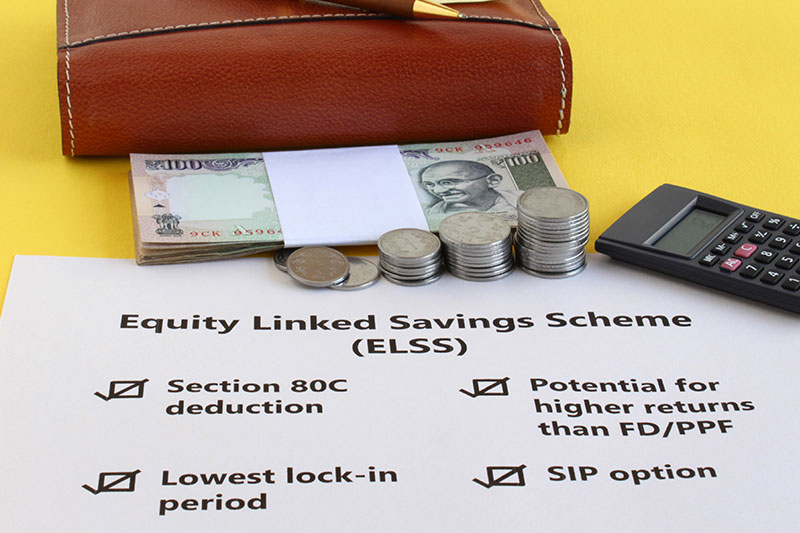6 MinsMay 25, 2022
A penny legitimately saved from tax is a penny earned. Ideally, tax planning and investment decision should go hand in hand. Among the various tax-saving instruments available, the Equity Linked Saving Scheme or ELSS is a worthy option. Let’s evaluate its benefits and why you should invest in it at the beginning of the financial year.

What is ELSS?
ELSS, also known as a tax-saving fund, is a diversified equity fund that offers the dual advantage of wealth-building potential and a tax-saving benefit under Section 80C.
The capital market regulator, the Securities and Exchange Board of India (SEBI) categorises ELSS as an open-ended equity-oriented mutual fund scheme that invests a minimum of 80% of its assets in equity & equity related instruments.
Typically, the fund manager of an ELSS deploys your invested money into a variety of stocks across market capitalisations (i.e., large-cap, mid-cap, and small-cap) and sectors. And as regards the investment style for portfolio construction, it could be of any genre––growth, value, or a blend of both.
Another distinguishing feature of an ELSS funds is the ‘compulsory lock-in’ period of 3 years, unlike other open-ended equity schemes. This means you cannot redeem or withdraw your investments until the end of the lock-in period. While this sounds like a deterrent, the 3-year lock-in period for ELSS is the shortest compared to other investment avenues.
Lock-in period of some tax-saving investments
| Tax Saving Instrument | Lock-in period |
|---|
| ELSS | 3 years |
| Unit-Linked Insurance Plan | 5 years |
| National Saving Certificate | 5 years |
| Tax-saver Bank FD | 5 years |
| Senior Citizens Savings Scheme | 5 years |
| Public Provident Fund | 15 years |
*50% of the balance can be withdrawn after expiry of 5 years from end of year of first subscription to the PPF account
Broadly, here are a few things to look at while selecting a good ELSS Fund/scheme:
- Point-to-Point returns over various time frames (6-months, 1-year, 2-year, 3-year, 5-year, 10-year, since inception)
- Performance across market phases (i.e. bull and bear phases)
- Risk and risk adjusted return ratios (Standard Deviation, Sharpe Ratio, Sortino Ratio, Treynor Ratio, etc.)
- The expense ratio of the scheme
- Portfolio characteristics (the top-10 holdings, top-5 sector exposure, portfolio concentration/diversification-, market capitalisation bias, investing style – value, growth, or blend, portfolio turnover, etc)
- The credentials of the fund management team (experience, number of schemes managed, track record of the schemes under his/her watch).
- The investment philosophy, processes, and systems of the asset management company.
Pick funds with a consistent track record and from a fundhouse following robust investment processes.
[Also Read: Make the most of your bonus, gifts with mutual funds]
At the end of 3 years, an investor - could either exit the scheme or continue to stay invested and enjoy the power of compounding.
If your risk profile as an investor is high and you have an investment time horizon of 3 to 5 years, then ELSS may be suitable for you.
Over the last 3 years and 5-year periods, ELSS as a category on an average basis has clocked a CAGR of 19.2% and 14.4%, respectively, as of April 13, 2022. While past performance is not indicative of future returns, it does display the return potential of equity as an asset class in general and ELSS schemes in particular.
Even after the imposition of 10% Long-Term Capital Gain (LTCG) -- on the capital gain over Rs 1 lakh, ELSS is comparatively more tax-efficient.
How to Invest in ELSS?
Preferably invest in ELSS at the start of the financial year rather than waiting for the end of the financial year. This will help you plan your tax-saving investments better. You will have ample time to select an ELSS most suitable for your needs and gain from staying invested in equities for a longer time.
The minimum application amount for most ELSS schemes is as little as Rs 500 with no upper limit. Ideally, you should invest a meaningful amount so that you would be able to optimally save tax.
You may invest a lump sum in one go, stagger your lump-sum investment during the financial year in parts, or take the Systematic Investment Plan (SIP) route. SIPs will help you mitigate market volatility and invest regularly and systematically in ELSS. But keep in mind that every SIP instalment, as well as staggered lump sum investment in an ELSS, will be subject to a lock-in period of 3 years.
What is the tax benefit?
Your investment in an ELSS or a tax-saving mutual fund will entitle you to a deduction of up to Rs 1.5 lakh per financial year under Section 80C of the Income Tax Act, 1961, helping you to save tax.
To select a suitable ELSS for tax-saving? Click here.
Disclaimer: This article has been authored by PersonalFN, a Mumbai based Financial Planning and Mutual Fund research firm. Axis Bank doesn't influence any views of the author in any way. Axis Bank & PersonalFN shall not be responsible for any direct / indirect loss or liability incurred by the reader for taking any financial decisions based on the contents and information. Please consult your financial advisor before making any financial decision.











